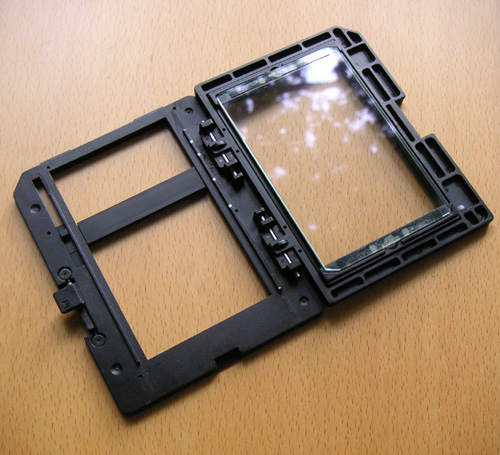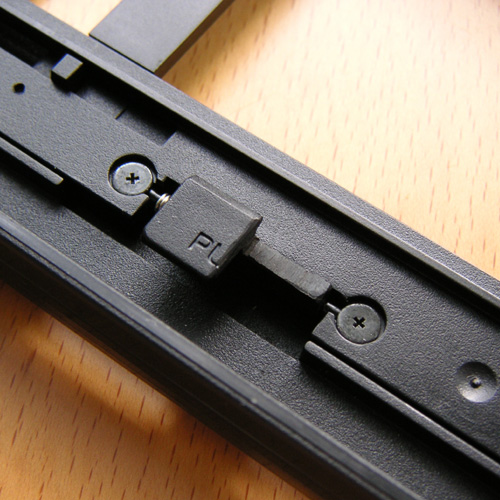

Should I use the glass filmholder or the glassless filmholder? This issue has been discussed at length, but so far the fight is undecided. Some find film flatness most vital, others find the avoidance of dust more important. However, the Scanhancer 5LE for MF is for the glass filmholder only, so you can guess in which camp I am. You are assumed to work very clean anyway, so the dust issue should not be a big problem with the glass holder. However, I do admit that there are still some issues related to scanning between glass that cannot be dismissed so easily. The first problem is that of Newton's rings. When the film heats up a little bit it can cause serious tension between the two glass surfaces, resulting in tight contact with the glass here and there. Newton's rings are likely to occur at those places. Another issue might be that glass sitting between the film and the CCD might cause loss of sharpness or resolution. There is no other option to deal with that problem than scanning without glass. The Final Solution It cost me quite some thinking, but finally the solution turned out to be so simple and obvious that one can only wonder why it wasn't done before. I constructed a single glass filmholder out of the Minolta glassholder and the glassless one. The glassless adjustable half at the bottom, the glass part on top. This construction takes care of all problems: - it keeps the film as flat as using two glass panes, because the film bends towards the light source; - it strongly helps avoiding Newton's rings because built up tension can easily flow away; - there is no optical loss under the film because there is no longer a glass surface there; - and finally even the ones who hate dust are being served because they lose half the number of glass surfaces, especially being the nasty ones. After working for some time with it now I can only say that it is really a pure joy to use this single glass filmholder.  This is how to make the single glass holder: Remove the little C-rings from the joints of both holders and pull out the axis pins. (Yeah, you need good eyes, a steady hand and a pair of tweezers.) Now you have to make a number of changes to the LOWER part of the glassless holder ONLY. After you have made these changes you can still use the lower part with its own top. Without limitations. But you will also be able to combine it with the top of the glass holder. This is what you have to do to the lower part of the glassless holder: 1. Remove 12 mm of all four ends of the two guiding ribs that keep the film in place. Use a shisel to carefully cut off layers until you are at the bottom level. 2. Saw off 1 cm of the right top side of the PUSH-button. Saw off only the top 4 mm and leave the lower part that forms the joint. So you should end with a push-button of about half its wideness.  3. Remove the protruding area between the hinges of the joints. Again use a shisel to do this. Lower the material until it is of te same level as the whole basic plate of the holder. Now you are ready to combine the two halves of both the glass holder and the glassless holder. Put in the axis pins and place back the C-rings. Finished! Two More Things A. When scanning, keep in mind that slide film must have its emulsion facing DOWN and B&W silverbased film must have its emulsion facing UP. This has to do with the direction in which both film types bend when heated up. They should of course flatten themselves against the glass and not bend away from the glass, thus raising possible flatness issues. (When you still get Newton's Rings with slide film, you could also place this type of film with the emulsion side up. All you should do is check a bit closer for sharpness over the full frame after scanning. Generally this works fine too. Just NEVER put in B&W film with the emulsion side down.) I have not found any effect on the rendering of the grain when the emulsion was up or down. The Scanhancer 5LE works equally well both ways. B. In order to get the best results in conjunction with the Dimage Scan Utility/plug-in, it is best to choose the settings for the glassless film holder. It seems that the settings for the glassholder apply some USM in order to hide sharpness loss caused by the second glass pane. We now don't need this compensation anylonger. Did you enjoy this mod? Then you should have a look at the Scanhancer LEK Manual (728kb) too! |